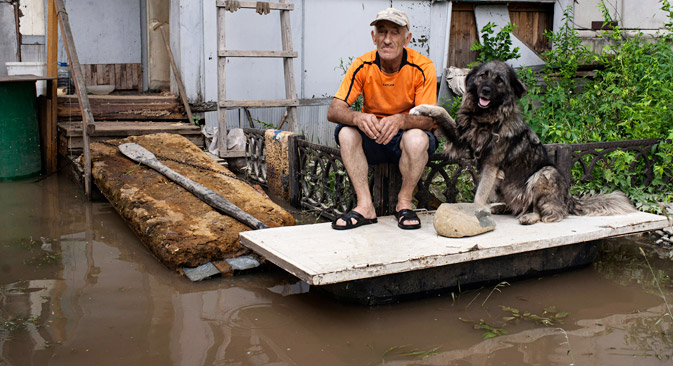
A man and his dog sit outside a house on a bank of the flooded Amur River, on the outskirts of Khabarovsk, Russia, Thursday, Aug. 22, 2013. The Russian Emergency Situations Ministry says around 20,000 people have been forced to leave their homes since July in the wake of floods in Russia’s Far East. Source: AP
The locals who have been fighting the high waters for the second month in a row are comparing the catastrophe to the Biblical Great Flood. Almost 30,000 people have been evacuated and almost 3,000 are in hospitals, mainly as a result of non-life threatening injuries and stress.
Khabarovsk’s flooded homes are being evacuated. Hydrologists are projecting the water will rise to the 325-inch mark by Sept. 5.
The Amur River has started to recede in some places along its mid-section by between 2 inches and 1.6 feet per day. Freezing cold will come in late September to the area where thousands of homes have been permanently damaged.
“We’ve been living in the attic for almost a month. The water is waist-deep inside the house and it’s impossible to stay there — it’s damp and moldy everywhere,” Marina Maslova, who lives in the village of Vladimirovka, said despondently. “Today we applied for a place to stay in a hostel, and we hope to move to normal living conditions soon.”
People are being sheltered at resorts and in army barracks. Homes that can still be salvaged are being dried out with space heaters: Three hundred of these have already arrived from the government emergency fund and 2,000 more are on the way.
The equipment is power-hungry, so, in an unprecedented move, the local authorities have decided to cut the electricity bills of affected residents by a third.
The government of China’s province of Heilongjiang on the other side of the border has offered help, but the Russians have declined: Their neighbors have been hit by natural disasters too; summer floods and hailstorms have affected 4.5 million people and resulted in 12 billion yuan ($1.9 billion) worth of damage.
Some 12 tons of international mail has piled up at customs in Heihe, because the Amur has submerged the cargo terminal. However, the river has started receding and two freight barges made their way across the Amur for the first time on Aug. 29, hauling equipment and three tons of mail over to the Russian side.
Meanwhile, in the Jewish Autonomous Region and Khabarovsk Region, the waters keep rising.
The water near Khabarovsk is close to the 25-foot mark; normally, at the end of summer and in early fall, it would hold at 15 feet. City residents, emergency workers and soldiers have installed 11 miles of levees that they attend to daily, in an attempt to outpace the rebellious Amur.
Water level in Amur may reach 830 centimeters mark by Friday
Photo of the day: A man windsurfs at the flooded stadium in Khabarovsk
The city’s island part has been nicknamed “Venice of the Far East,” as its streets have turned into canals filled with muddy, fast-flowing water. The governor personally pleaded with residents to evacuate the threatened area, but more than 100 islanders have stubbornly remained in their flooded homes: They stocked up on cereals, sugar and ramen noodles.
Emergency workers regularly bring them bread and drinking water by boat. High-rise apartment buildings have turned into communes of sorts, where people who live on the upper floor are letting their neighbors from lower floors into spare rooms in their apartments.
Vladimir Nikolaevich, retired, has become a local celebrity. He has been fasting for days and praying for an end to the plight. He says that people should be grateful for the trials the higher powers send them. Whenever rescuers paddle to his house in a boat, he starts preaching to them with gusto from his rooftop.
Evacuations have started in Komsomolsk, the Far East’s industrial powerhouse. Nuclear submarines, as well as military and civil medium-haul aircraft, are usually built there—but it is levees that are being built there today.
Russia’s president has visited the submerged areas; he flew over the endless spread of water in a helicopter and talked to local residents. “We have never experienced a catastrophe on this scale before,” Vladimir Putin said, instructing the Investigative Committee to check if officials’ actions during the flooding complied with the laws and regulations.
Putin also visited 20 evacuees at a temporary shelter. One of the city’s three thoroughfares was closed to make way for the presidential motorcade. Another highway was closed by the Amur, which eroded the road in several places. As a result, traffic ground to a halt in half of Khabarovsk, which a city of 600,000.
After the head of state’s visit to the flooded area, his special envoy to the Far East Federal District and minister for Far East development, Viktor Ishaev, was fired. Presidential aide Yuri Trutnev has become the new envoy.
The Russian government will decide who will fill the ministerial post. According to official statements, the reshuffle had nothing to do with the flooding and the decision regarding Ishaev was made a month ago.
According to projections, the flood will peak at the Amur’s mouth in 15–20 days. The water will then take several weeks to recede.
“The climate is changing, and very vigorously at that. Global warming and human economic activity are having a tremendous impact on the environment. This includes the building of hydropower plants and wildfires. Dams accumulate huge quantities of water in early summer and, after the water level rises naturally, heaps of water from reservoirs get dumped into the river,” said Boris Voronov, director of the Water and Environmental Problems Institute of Russia’s Academy of Sciences.
“Reservoirs are emptied not only on the Russian side. China also has dams and produces a huge impact on the water level in the Amur.”
All rights reserved by Rossiyskaya Gazeta.
Subscribe
to our newsletter!
Get the week's best stories straight to your inbox